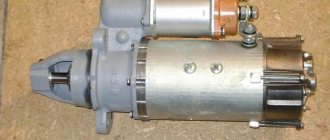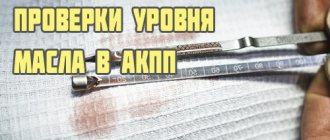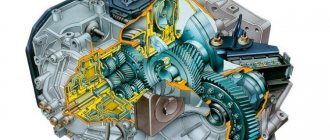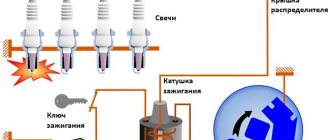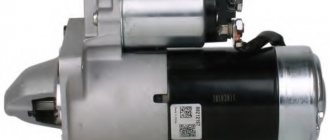Modern automatic transmissions are necessarily equipped with solenoids, which are in fact small solenoid valves-controllers. Such valves are responsible for opening/closing the oil channel in the hydraulic plate in accordance with impulses received from the ECU. In the past, automatic transmission solenoids were quite simple. Modern valves are much more complex, but at the same time, they practically do not wear out the hydraulic plate. Let's look at the structure and malfunctions of such solenoids.
Briefly about the functions
Automatic transmission solenoids consist of a metal rod that is wrapped in a coil of conductive material. A current operates in the spiral, as a result of which, under the influence of electromagnetic forces, the rod begins to move, thereby creating spaces for the movement of oil. The rod returns to its original position under the action of a spring. This is the simplest design, which has been supplemented many times by various companies and automakers. Automatic transmission solenoids, as stated, provide oil flow or interruption. By monitoring the oil pressure in the transmission system, you can regulate its supply to the clutches, effectively change gears, and also enable and disable the torque converter lock-up. The solenoids work in tandem with the electronic control unit. The block is connected to the solenoid valves through special loops capable of transmitting a control signal.
Automatic transmission solenoid design
Since about the 80s of the last century, solenoids began to be actively used in automatic transmissions. The design of that time, today called On-Off , was distinguished by its simplicity and low cost. At the same time, the old solenoids suffered from open circuits in the windings and short circuits. In addition, the weakening of the spring meant that the oil passage would either not close in time or would stop closing completely. The further evolution of the solenoids is as follows:
- Volvo solenoids . The design was supplemented with a pushing core, a mesh filter in the channel and a special metal ball valve. The oil channel had two outlets at once. Essentially, it is a hydraulic valve and electrics in one housing. The solenoid valve has two positions: normally open and normally closed. When the valve is de-energized, the spring closes. As operation progressed, it became clear that this design turned out to be quite complex and the device failed too often;
- Three-channel solenoids (3-way). The peculiarity of such solenoids is that they connect 3 channels. In the first position, the ball allows the oil to move from the first channel to the second, and in the second position, a passage opens from the second channel to the third. Before the advent of such a solenoid, pressure was relieved from the clutch pack by a special mechanical valve, however, 3-way solenoids, being in the second position, could take on this task.
- Solenoid types PMW (pulse width modulation), VBS (variable skip), VFS (variable force). These are full-fledged regulator solenoids, operating on the principle of a “valve” rather than a “faucet”. PMW solenoids are actively used to control the secondary spool. More complex VBS have performed quite well: they are sensitive to even small fluctuations in supply pressure and effectively control low pressure flow. Most sophisticated VFS solenoids can handle both high and low pressure, but are not sensitive to changes in supply pressure.
Separately, it is worth noting the linear solenoids. They are often called proportional. Their largest designer and manufacturer is the Japanese company Aisin Co. The design of the solenoids provides for the presence of a movable spool-plunger with holes. Such solenoids allow the hydraulic plate to be operated in a gentle mode, since its most wear-out area was placed directly into the valve.
Classification by purpose
Modern automatic transmission solenoids are classified not only by design features, but also by purpose (functions). Moreover, in recent years, new types of solenoids have appeared, as a result of which the classification of these devices may seem very complicated to the average car enthusiast. Let's try to figure it out.
The most common solenoids are labeled as EPC, LPC and TCC. EPC and LPC solenoids are also called line pressure control solenoids. Essentially, these are control devices that distribute oil to all other solenoid valves and allow it to move into the channels. As a rule, they are the first to fail.
TCC solenoids (also available as SLU ) are responsible for controlling the locking of the hydraulic transformer. Such valves take on the task of connecting and locking the torque converter clutch, which makes it possible to increase the efficiency of the gearbox and achieve sharp acceleration, as may be required by a sporty driving style. The problem is that hot and contaminated oil from the torque converter passes through the solenoids. Dirt in the oil (graphite, metal shavings, Kevlar) is formed as a result of the load on the clutches and other elements of the gearbox. Since modern gearboxes feature a “controlled slip” mode with accompanying oil heating, TCC solenoids operate under very harsh conditions. Like EPC or LPC solenoids, they fail frequently.
Switch solenoids, which are more correctly called Shift Solenoid , are responsible for changing speeds. Usually there are several of them. They have the following designations S1, S2,. (or SL1,... if the switch is linear). Sometimes denoted by the Latin letters A, B,. Referring to technical manuals, you can see combinations of open and closed valves corresponding to switching from one speed to another. The more stages in the gearbox, the more complex these combinations are. The relationship “3 speed = 3 solenoid” not always correct, so if problems arise with one of the speeds, you do not need to prepare to replace the solenoid of the corresponding order - first, you should have it diagnosed by a specialist.
As for new types of solenoids, everything is relatively simple. A control solenoid is identified, which takes on the task of controlling the hydraulic plate valves. A variation of the control valve, the oil cooling control solenoid works in much the same way as a thermostat - it opens a channel through which oil can flow through an external radiator. Also worth highlighting is the shift quality solenoid. It engages only when the gear is changed, guaranteeing a soft “slip.”
Communities › All about automatic transmissions › Blog › Installing an additional radiator to cool automatic transmission oil
Hi all!
Soon the warmth will come, and willy-nilly you will want to press down on the pedal more, especially when the horses allow it. But the question that worries me is how the box feels. Why is it disturbing, because on this car there were many complaints about the 8-speed gearbox (foaming, slipping, switching to emergency mode, etc.). Mostly such complaints occurred in the summer, and then it was decided to check the oil temperature. One of my friends installed a remote temperature sensor on the same car and we saw that it easily rises to 120 degrees, and if we continue to drive further in traffic light mode, the needle creeps even higher. After reading various forums and articles on the Internet, it became clear that the cause of transmission failure could be “non-operating oil temperature in the automatic transmission.” For example, above 100 degrees, which is approximately 20° higher than the operating temperature. Due to the increase in temperature, the viscosity of the oil in the box decreases, which leads to its not entirely correct operation. A further increase in temperature leads to accelerated wear of the automatic transmission. In addition to the factors of dynamic driving on a fly (This can also include: chip tuning, installing water injection, replacing the standard turbine with a more powerful one, etc. Everything that leads to an increase in the power of the car.), one must also take into account external factors: The location of the box, asphalt temperature in summer, automatic transmission protection, traffic jams. All these factors lead to an increase in temperature in the automatic transmission.
By the way, here is a short excerpt from the forum www.bmwclub.ru/index.php?…ratura-masla-akpp.859874/
The optimal operating temperature of ATF oil is 75 - 85. At this temperature, almost any transmission can survive the car itself. Progress has led to the fact that the normal engine coolant temperature has increased to 120-130 degrees, and the ATF fluids themselves have become completely synthetic with an increased “flash point”. But if the oil can already withstand elevated temperatures, then for the automatic transmission itself, every 10 degrees increase in operating temperature shortens the life of many elements, for example: clutches, electrical equipment, wires, rubber by several years. When the oil temperature reaches 140 degrees, in addition to the problem of hardened rubber seals, the processes of carbonization of the friction clutches begin. And even modern “non-replaceable” synthetic oils can only slightly delay, but not cancel, the premature death of the friction lining, which heats up to 300-400 degrees at certain moments. In addition, the cooling ability of the oil decreases significantly with an increase in its viscosity and the suspension of friction dust in the oil. And clutches have recently been made from heat-resistant carbon compounds, which, like asbestos, have low thermal conductivity, which leads to a significant loss of the ability of dirty oil to pick up excess heat from friction surfaces.
Many experts say that the main way to extend the life of an automatic transmission is to improve the system, and only in second place is timely oil changes.
In view of the above, it was decided to install an additional cooling radiator with a remote thermostat. This scheme allows not only to extend the life of the automatic transmission (by properly cooling it), but also to maintain its operating temperature, which in turn has a positive effect on driving dynamics and comfort.
After installation, the temperature in the box in the summer at 30°C rose as much as possible (with progressive driving) to 104°C. In winter, the box temperature after warming up with Webasto and a 20-minute drive showed 76°C. The thermostat does its job, and the radiator does its job.
At the moment, the system also has a built-in oil radiator cooling fan with automatic operation within the specified temperatures. The temperature is set using the fan controller and is individual. My friend, an electronics engineer from www.faradayauto.ru/ or Max-Unitd, helped me in developing the controller, and on the technical side we worked together with a teammate from the mohave.su forum
I'll attach photos of the fan with the controller later, the next time I remove the bumper.
Location of automatic transmission solenoids and their service life
You need to look for solenoid valves in the lower part of the gearbox - in the hydraulic valve plate, otherwise called the valve body. The valves are secured using bolts or a pressure plate. In some automatic transmission models, the valve body is located not at the bottom of the unit, but on the side. In both cases, you can see cable wiring with leads to plugs that connect the solenoids to the on-board electrical system.
Due to the variety of design solutions, it is simply impossible to speak confidently about the service life of the solenoids. You can only note some of their features and refer to information from the manufacturers. For example, some of the most common automatic transmissions are equipped with VFS solenoids On average, such regulators require replacement every 3-5 years of active use. Such a short resource is due to the fact that due to wear in the solenoids, the degree of opening of the channel changes. The control unit adapts to such changes, but only up to a certain point. Simpler PMW solenoids today are assembled from anodized parts, so the product becomes more durable - the service life is 6-7 years, often even more. Very common linear solenoids usually last about 5-6 years. In some cases, even a worn-out device can be “reanimated” by cleaning, replacing the bushing, seals, rings and other elements.
Read more about automatic transmission solenoid faults
In modern transmissions, PWW type valves may not work efficiently enough, to which the electronic control unit will respond, but will not fail immediately. If the computer throws a "trouble code" such as OBDII: P2714 , the solenoid has completely failed. For other types of devices, failure may occur suddenly. Here are the main reasons:
- Severe wear of the inlet, plunger elements, and leaks. Practice has shown that the more contaminated the oil is, the faster the solenoid wears out. This is the main reason why PWW valves fail;
- The appearance of cracks on the solenoid body, open circuit of the winding, abnormal operation of the circuit (short circuit), weakening of the return spring. Valid for all solenoids. Rewinding, soldering, as well as cleaning and replacing bushings often helps;
- Contamination of the solenoid with wear products, the appearance of carbon deposits. Practice shows that the spool valves of the solenoids begin to work poorly after the oil warms up. The problem also occurs with cold oil, but much less frequently. Cleaning the solenoid or valve body element using solvents or ultrasound often helps. Experts also recommend demagnetization.
In the vast majority of cases, solenoids fail as a result of wear of the channels, ball or plunger, as well as valve, manifold and bushings. The process of wear of these elements begins with contamination of the solenoid. Bronze bushings wear out the fastest, while other solenoids, often made of anodized alloys , wear out for a very long time. If the device is removed, cleaned, optionally replacing worn parts, and also changing the oil, problems with the automatic transmission may disappear for a long time.
Checking automatic transmission solenoids
The first thing you should pay attention to is the quality of gear shifting. If it becomes too difficult to shift into one of the gears, and the driver also feels shocks and impacts, you need to check the valves. The second point: the appearance of chips in the pan. Third: the above error appears on the on-board computer. You should not immediately go to the store and select the appropriate solenoid. Perhaps the existing valve can still be “reanimated”. But first you need to check it. Let us immediately note that the most modern models of solenoids cannot be tested at home. For example, the failure of a PWM can only be determined by a qualified electrician. If the transmission has older solenoids or the problem is not related to the control device, do the following to check:
- Remove the valve body from the gearbox (located in the lower part of the unit, less often in the upper);
- Disconnect the contacts of each solenoid;
- Check the resistance of each solenoid with an ohmmeter. The resistance standards of the solenoids are different, so you can’t do without technical documentation. Below is a table with resistance standards for some solenoids (take into account the temperature!).
Spare parts for Samand norma
Turn signal on the wing
NORMA sedan (06 — )
Spare parts for Mazda 2
Oil pump 2 hatchback (DE) (06.07 - 06.15)
Do not forget that the on-board systems of modern cars have a self-diagnosis . It is possible that the solenoids will not have to be “ringed”—it will be enough to connect to the computer. If this fails, the only method left is using an ohmmeter. We also advise you to make sure that the wiring harness is intact. If the gearbox is equipped with the most modern solenoids, only a specialist can diagnose them.
How to recognize a breakdown?
An automatic transmission solenoid in the event of a malfunction can be identified by several signs:
1. Your automatic transmission has become much more likely to change into emergency mode.
2. If sharp shocks appear during standard speed mode switching.
3. If, with a smooth increase in speed, knocks in the gearbox are clearly audible.
Thus, having noticed such signs in the car, the owner urgently needs to carry out in-depth service diagnostics and, if detected, resort to automatic transmission repair. Because in such cases, service center technicians most often detect faulty solenoids.
Selecting a New Solenoid
Determining the correct solenoid and installing it is a critical process in which mistakes are not tolerated. an ordinary car enthusiast can easily handle this job . Online guides and manuals from automakers and automotive electrical manufacturers will help him with this. Here are the search options:
- Search for a spare part by VIN code;
- Search by code of the existing solenoid;
- Search for the solenoid according to the vehicle and gearbox parameters.
The last option is the most difficult. First, you need to determine the type of automatic transmission, which can cause problems - one car model in different years could be equipped with different units. It is best to study the information on the nameplate of the gearbox itself. Next, you need to refer to the manuals for this automatic transmission. It contains all the information about the valve body and the solenoids with which it is assembled. In modern online stores, the search for a solenoid is simplified: the buyer selects the desired car model, year of manufacture, engine and gearbox parameters. This search option is not always an accurate result, especially if the online store does not have a high-quality database of cross-numbers for auto parts.
If you decide to take not the original solenoid, but its analogue, then you can be almost completely sure that it is produced by the same company that works for automakers. Among the most famous manufacturing companies it is worth noting Aisin, Borg Warner, ZF, Bosch. Good solenoids are also offered by Maktrans, Dorman, Meat&Doria. We do not recommend taking analogues from Danish, Polish and German packagers of budget auto parts.
Riding character
As surprising as it may seem, the service life that the solenoid can serve you largely depends on the nature of your car’s driving. Experts say that a softer, leisurely ride on the car significantly extends the life of the solenoids.
But if you are a fan of a more aggressive manner of driving your car, then you should know that frequently pressing the gas pedal and frequently changing gears will cause failure of work, failure of the solenoid, wear in the literal sense of the word, literally in the first hundred kilometers .
Wear of the plunger will also cause the valve to fail, an irregular current supply will be observed, then you will notice that the lubricant is poorly supplied to the automatic transmission, then you will see poor functionality of the valve body and the gearbox as a whole, and so on. That is, banal excessive use of the clutch pedal can lead to automatic malfunction and disruption of the solenoid valve.
Conclusion
Faulty automatic transmission solenoids should never be ignored. If the valve fails, the effect will be the same as when the clutch on a manual transmission is not depressed. The clutch pack will begin to slip, and the friction clutches will wear out catastrophically quickly. If at least one solenoid fails, it is necessary to diagnose, clean and repair the device, or buy a new one. Fortunately, the secondary auto parts market is open even to car enthusiasts from remote regions. We recommend buying original spare parts or analogues under the names of well-known brands. Do not forget to check the authenticity of the products - you can even find counterfeit solenoid valves on the secondary market.
Signs and causes of malfunctions
As follows from the principle of operation, problems with the control valves will appear during gear shifts. The box will begin to “kick”, that is, the smoothness of gear changes will disappear, unpredictable and unnecessary shifts will begin, or the automatic transmission may freeze in one of the gears. The adequacy of management will be lost. Most often this is due to lost quality or contaminated oil in the automatic transmission. Such a product, passing through the valves, will clog them, after which the delicate hydraulics of the spools and plungers will no longer be able to operate smoothly.
Typically, control electronics immediately notice incorrect reactions to their commands, since the standard model of automatic transmission operation is hardwired into its memory in the form of a built-in microprocessor program. And if the controller wants one thing, but something completely different happens, it itself will notice signs of a malfunction of the automatic transmission solenoids and will react by lighting up the malfunction lamp on the driver’s dashboard. It is necessary to disassemble the box and check the valve body, although in some cases it is possible to get by by changing the oil and filter.
Why do you need to change solenoids?
Replacement will not always be necessary. Sometimes it is quite possible to repair the automatic transmission solenoid yourself. There are even repair kits for this, although of course not every part can be done this way. Replacement rather than repair is a global trend in automotive technology. However, if the valve can be disassembled, you can check it by testing the electrical part, windings and supply wiring with connectors, clean the parts from dirt and metal shavings that got there with the oil, and make sure that its normal operation is restored. The part will still work in clean oil.
Cleaning the automatic transmission solenoids is unlikely to be necessary if you regularly change the oil in the gearbox, even despite the manufacturer’s assurances that it does not require this throughout its entire service life. It is so, only this period will be very short. Within the limits of the vehicle's factory warranty. In fact, the gearbox can last much longer, but wear debris from thin hydraulic parts must be removed more often by regularly changing the oil.
Like all other car parts, they cannot work forever without failure or deterioration in their functionality. And a lot in the box depends on them; these valves control the operation of components that carry a large load of engine torque. And the slightest deviations in the control hydraulics will result in major problems with the gearbox as a whole. Uncertain operation of the clutches will lead to increased wear, the products of which will scatter with oil throughout the entire unit, destroying all other parts. And changing the oil will only help temporarily. Therefore, it is better to replace a used part on time.
Knowing how to check an automatic transmission solenoid, you can make the best decision whether to change it or try to restore it.
